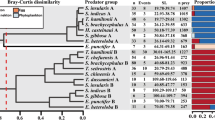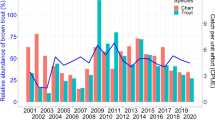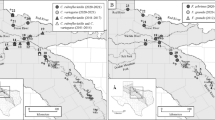Abstract
We quantified temporal and spatial variability in diets of 950 juvenile (age-0) striped bass in the Hudson River estuary. We used canonical correspondence analysis to assess the roles of temporal and spatial habitat variability in juvenile diet variation. We found that juvenile striped bass diets in the Hudson River were only modestly comparable to diets in other east coast estuaries. Among-year differences (51.4%) and spatial differences (41.9%) were substantially associated with juvenile striped bass diet. We found ontogeny (2.8%) and within-season variation (9.5%) to only weakly associate with diet variation. Our results indicate that an understanding of the temporal and spatial variation within the Hudson River estuary is vital in understanding variation in feeding by resident juvenile fish.
Similar content being viewed by others
Literature Cited
Ahrenholz, D. W. 1991. Population biology and life history of the North American menhadens,Brevoortia spp.Fishery Bulletin 53:3–19.
Barnthouse, L. W., R. J. Klauda, D. S. Vaughan, andR. L. Kendall (eds.). 1988. Science, Law, and Hudson River Power Plants: A Case Study in Environmental Impact Assessment. American Fisheries Society Monograph 4. American Fisheries Society, Bethesda, Maryland.
Beck, M. W., K. L. Heck, Jr.,K. W. Able, D. L. Childers, D. B. Eggleston, B. M. Gillanders, B. Halpern, C. G. Hays, K. Hoshino, T. J. Minello, R. J. Orth, P. F. Sheridan, andM. P. Weinstein. 2001. The identification, conservation, and management of estuarine and marine nurseries for fish and invertebrates.BioScience 51:633–641.
Boreman, J. andR. J. Klauda. 1988. Distributions of early life stages of striped bass in the Hudson River estuary 1974–1979, p. 53–58.In J. Boreman and R. J. Klauda (eds.), Science, Law, and the Hudson River Power Plants: A Case Study in Environmental Impact Assessment, Volume 4. American Fisheries Society, Bethesda, Maryland.
Boynton, W. R., T. T. Polgar, andH. H. Zion. 1981. Importance of juvenile striped bass food habits in the Potomac estuary.Transactions of the American Fisheries Society 110:56–63.
Buckel, J. A. andD. O. Conover. 1997. Movements, feeding periods and daily ration of piscivorous young-of-the-year bluefish (Pomatomus saltatrix) in the Hudson River estuary.Fishery Bulletin 95:665–679.
Buckel, J. A., D. O. Conover, N. D.Steinberg, andK. A. McKown. 1999. Impact of age-0 bluefish (Pomatomus saltatrix) predation on age-0 fishes in the Hudson River estuary: Evidence for density-dependent loss of juvenile striped bass (Morone saxatilis).Canadian Journal of Fisheries and Aquatic Sciences 56:275–287.
Clausen, S. E. 1998. Applied Correspondence Analysis: An Introduction. Sage Publications, Thousand Oaks, California.
Cooper, J. C., R. A. Rulifson, J. J. Isely, andS. E. Winslow. 1998. Food habits and growth of juvenile striped bass,Morone saxatilis, in Albemarle Sound, North Carolina.Estuaries 21: 307–317.
Dovel, W. L. 1992. Movements of immature striped bass in the Hudson estuary, p. 276–300.In C. L. Smith (ed.), Estuarine Research in the 1980's. State University of New York Press, Stony Brook, New York.
Gardinier, M. N. andT. B. Hoff. 1982. Diet of striped bass in the Hudson River estuary.New York Fish and Game Journal 29: 152–165.
Garrison, L. P. andJ. S. Link. 2000. Diets of five hake species in the northeast United States continental shelf ecosystem.Marine Ecology Progress Series 204:243–255.
Hartman, K. J. andS. B. Brandt. 1995a. Predatory demand and impact of striped bass, bluefish, and weakfish in the Chesapeake Bay: Applications of bioenergetics models.Canadian Journal of Fisheries and Aquatic Sciences 52:1667–1687.
Hartman, K. J. andS. B. Brandt. 1995b. Trophic resource partitioning, diets and growth of sympatric estuarine predators.Transactions of the American Fisheries Society 124:520–537.
Houde, E. D. andE. S. Rutherford. 1993. Recent trends in estuarine fisheries; predictions of fish production and yield.Estuaries 16:161–176.
Hurst, T. P. andD. O. Conover. 1998. Winter mortality of young-of-the-year striped bass (Morone saxatilis): Size-dependent patterns and effects on recruitment.Canadian Journal of Fisheries and Aquatic Sciences 55:1122–1130.
Hurst, T. P. andD. O. Conover. 2001. Diet and consumption rates of overwintering YOY striped bass,Morone saxatilis, in the Hudson River.Fishery Bulletin 99:545–553.
Juanes, F., R. E. Marks, K. A. McKown, andD. O. Conover. 1993. Predation by age-0 bluefish on age-0 anadromous fishes in the Hudson River estuary.Transactions of the American Fisheries Society 122:348–356.
Limburg, K. E. andR. E. Schmidt. 1990. Patterns of fish spawning in Hudson River tributaries; response to an urban gradient.Ecology 71:1238–1245.
Livingston, R. J., X. Niu, F. G. Lewis, III, andG. C. Woodsum. 1997. Freshwater input to a gulf estuary: Long-term control of trophic organization.Ecological Applications 7:277–299.
Markle, D. F. andG. C. Grant. 1970. The summer food habits of young-of-the-year striped bass in three Virginia rivers.Chesapeake Science 11:50–54.
Marks, R. E. andD. Conover. 1993. Ontogenetic shift in the diet of young-of-year bluefishPomatomus saltatrix during the oceanic phase of the early life history.Fishery Bulletin 91:97–106.
Maser, C. andJ. R. Sedell. 1995. The estuary. p. 57–87.In C. Maser and J. R. Sedell (eds.), From the Forest to the Sea: The Ecology of Wood in Streams, Rivers, and Oceans. St. Lucie Press, Boca Raton, Florida.
McKown, K. A. andR. Gelardi. 2000. An investigation of the 1998 Hudson River striped bass spawning success. New York State Department of Environmental Conservation, East Setauket, New York.
Merritt, R. W. andK. W. Cummins. 1996. Aquatic Insects of North America. Kendall/Hunt Publishing Co., Dubuque, Iowa.
Palmer, M. W. 1993. Putting things in even better order: The advantages of canonical correspondence analysis.Ecology 74:2215–2230.
Richards, R. A. andP. J. Rago. 1999. A case history of effective fishery management: Chesapeake Bay striped bass.North American Journal of Fisheries Management 19:356–375.
Robichaud-LeBlanc, K. A., S. C. Courtenay, andJ. M. Hanson. 1997. Ontogenetic diet shifts in age-0 striped bass, (Morone saxatilis), from the Miramichi River estuary, Gulf of St. Lawrence.Canadian Journal of Zoology 75:1300–1307.
Rulifson, R. A. andS. A. McKenna. 1987. Food of striped bass in the upper Bay of Fundy, Canada.Transactions of the American Fisheries Society 116:119–122.
Schmidt, R. E. 1993. Fishes of Manitou Marsh with comments on other aquatic organisms. Report prepared for the Museum of the Hudson Highlands, Annandale, New York.
Stevens, D. E., D. W. Kohlorst, andL. W. Miller. 1985. The decline of striped bass in the Sacramento-San Joaquin estuary, California.Transactions of the American Fisheries Society 114:12–30.
Ter Braak, C. J. F. 1986. Canonical correspondence analysis: A new eigenvector technique for multivariate direct gradient analysis.Ecology 67:1167–1179.
Wainwright, S. C., C. M. Fuller, R. H. Michener, andR. A. Richards. 1996. Spatial variation of trophic position and growth rate of juvenile striped bass (Morone saxatilis) in the Delaware River.Canadian Journal of Fisheries and Aquatic Sciences 53:685–692.
Weiss, H. M. 1995. Marine Animals of Southern New England and New York. DEP Bulletin 115. Connecticut Department of Environmental Protection. Hartford, Connecticut.
Wirgin, I. I., T. L. Ong, L. Maceda, J. R. Waldman, D. Moore, andS. Courtenay. 1993. Mitochondrial DNA variation in striped bass (Morone saxatilis) from Canadian rivers.Canadian Journal of Fisheries and Aquatic Sciences 50:80–87.
Author information
Authors and Affiliations
Corresponding author
Rights and permissions
About this article
Cite this article
Jordan, R.C., Howe, D.V., Hurst, T.P. et al. Feeding habits of age-0 striped bass,Morone saxatilis, in the mid-Hudson River estuary: Temporal, spatial, and ontogenetic variation. Estuaries 26, 1486–1493 (2003). https://doi.org/10.1007/BF02803657
Received:
Revised:
Accepted:
Issue Date:
DOI: https://doi.org/10.1007/BF02803657




